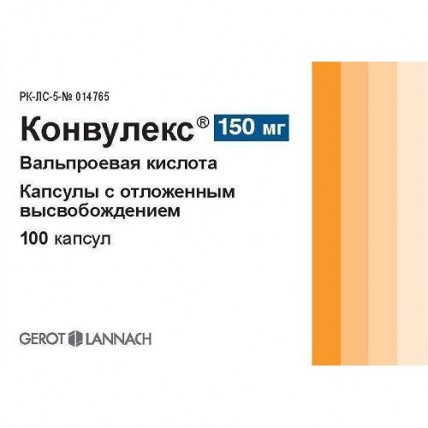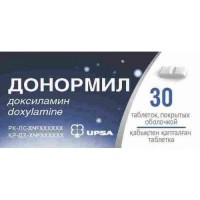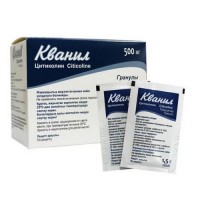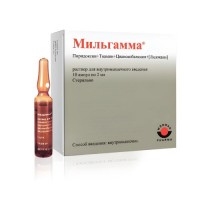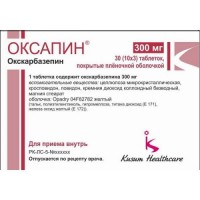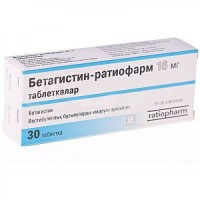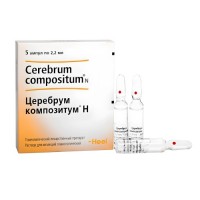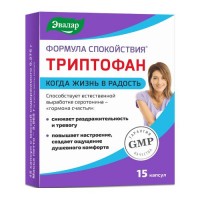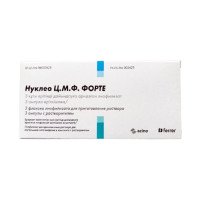Konvuleks 100s 150 mg capsule
- $23.80
The instruction for medical use
of Konvuleks® medicine
the Trade name
of Konvuleks®
the International unlicensed
name Acid a valproyevy
Dosage form
of the Capsule with the postponed release of 150 mg, 300 mg, 500 mg
Structure
One capsule contains
active agent - valproic acid of 150, 300 or 500 mg,
structure of a cover of the capsule: the hydrogenated hydrolyzed starch (Karion 83), glycerin (glitserol) 85%, gelatin, the titan dioxide (E171), ferrous oxide red (E172), acid of chlorohydrogen 25%,
an enterosoluble covering: 30% dispersion of methacrylic acid - ethyl acrylate copolymer (1:1) (Eudragit of L30D), triethyl citrate, a macrogoal 6000, a glitserola monostearate 44-55 type II,
the Description
Soft gelatin capsules of an oval form, pink color, 3 in size, about 9.8 mm long and with a diameter about 7.3 mm (for a dosage of 150 mg).
Soft gelatin capsules of an oval form, pink color, 6 in size, about 13.5 mm long and with a diameter about 8.1 mm (for a dosage of 300 mg).
Soft gelatin capsules of oblong shape, 9.5 in size, about 21.1 mm long and with a diameter about 7.8 mm (for a dosage of 500 mg).
Contents of capsules – liquid from colourless till slightly yellowish color with a slight characteristic smell.
Pharmacotherapeutic group
Antiepileptic drugs. Fatty acids derivatives. Valproic acid.
The ATX N03AG01 code
the Pharmacological
Capsule Pharmacokinetics properties in a kishechnorastvorimy cover release active agent only in a small intestine where it also is soaked up. Valproic acid quickly and almost is completely soaked up in digestive tract, the bioavailability at intake is 100%. Meal does not reduce absorption speed. The maximum level of concentration in plasma is noted in 2-3 h. Equilibrium concentration is reached for the 2-4th day of treatment, depending on dosing intervals. Therapeutic concentration of drug in blood plasma fluctuates within 40-100 mg/l. Valproic acid is connected with proteins of plasma for 90-95% at concentration in blood plasma up to 50 mg/l and for 80-85% at concentration of 50-100 mg/l, in uraemia, a hypoproteinemia and cirrhosis the linking with proteins is reduced. Concentration level in cerebrospinal fluid correlates with the size of the fraction of drug which is not connected with proteins. Valproic acid gets through a placental barrier, is emitted with breast milk. Concentration in breast milk makes 1-10% of concentration in blood plasma of mother. Drug is exposed to a glyukuronirovaniye and oxidation in a liver, metabolites and not changed valproic acid (1-3% of a dose) are removed by kidneys, small amounts are removed with excrements and with expired air. The period of removal of drug is at healthy and at monotherapy from 10 to 15 h, at children it is shorter than 6 - 10 h, at patients with an abnormal liver function and elderly patients can be much longer.
The pharmacodynamics
Convulexum – antiepileptic means, also has the central myorelaxation and sedative effect. The mechanism of action is caused mainly by inhibition of enzyme of GAMK-transferase and increase in content of piperidic acid in the central nervous system. Piperidic acid interferes pre- and to postsynaptic categories and, thereby, prevents distribution of convulsive activity in the central nervous system. Besides, in the mechanism of effect of drug the essential role belongs to impact of valproic acid on receptors of piperidic acid A and also influence on a voltage - dependent Na-channels. Affects sites of postsynaptic receptors, imitating or enhancing the braking effect of piperidic acid. Potential direct impact on activity of membranes is connected with changes in conductivity of potassium. Improves a mental condition and mood of patients, has antiarrhytmic activity.
Indications
- epileptic seizures (including generalized and partial and also against the background of organic diseases of a brain)
- prevention of attacks of migraine
- the manic-depressive syndrome with a bipolar course when lithium is contraindicated or is not transferred by the patient
the Route of administration and doses
take the Drug inside, without chewing, 1 – 2 time a day, in time or after a meal, with a small amount of liquid. Duration of use is defined by the doctor.
Adults
the Initial dose at monotherapy - 5-15 mg/kg/days, at combination therapy – 10-30 mg/kg/days then this dose gradually increase by 5-10 mg/kg/week.
An average daily dose - 20-30 mg/kg of body weight.
The daily dose can be increased up to 60 mg/kg at a possibility of the organization of control of concentration of drug in blood plasma.
For use for children to the 6th summer age the following forms of the drug Convulexum are recommended: drops for intake and syrup for children.
The dosage at children of 6 years is also more senior makes 10-20 mg/kg with gradual increase up to 20-35 mg/kg a day. At children who need a dose higher than 40 mg/kg a day biochemical and hematologic parameters have to be traced.
Advanced age
Though the pharmacokinetics of Valproatums at advanced age has the features, it has limited clinical value, and the dose should be determined by clinical effect. Owing to reduction of linking with seralbumin the share of untied drug in plasma increases. It causes expediency of more careful selection of a dose of drug at elderly, with possible use of smaller doses of drug.
Patients with a renal failure
It can be necessary to lower a drug dose. The dose should be selected for monitoring of a clinical state as concentration indicators in plasma can be insufficiently informative.
Average daily doses:
The age
the Body weight (kg)
the Average dose of mg/day
of 6 years
of 15-20 kg
of 450-600
7-11 years
of 20-40 kg
of 600-1200
12-17 years
of 40-60 kg
1000-1500
Adult and elderly
More than 60 kg
1200-2100
Side effects
Convulexum is well transferred by patients. Side effects are possible generally at drug level in plasma higher than 100 mg/l or at the combined therapy.
Often (from ³1/100 to & lt, 1/10 cases)
- nausea, vomiting, anorexia or increase in appetite, diarrhea, gastralgias, hepatitis
- a tremor
- a diplopia, flashing of 'front sights' before eyes
- anemia, thrombocytopenia, the decrease in content of fibrinogen, aggregation of thrombocytes and blood clotting which is followed by lengthening of a bleeding time, petekhialny hemorrhages, bruises, hematomas, bleeding, an agranulocytosis, a lymphocytosis
- decrease or increase in body weight
- a giperkreatininemiya, a giperammoniyemiya, a giperglitsinemiya, a hyperbilirubinemia, insignificant increase in activity of 'hepatic' transaminases, LDG (dose-dependent)
- a dysmenorrhea, a secondary amenorrhea, increase in mammary glands, a galactorrhoea
- peripheral hypostases, a hair loss (as a rule, it is restored after drug withdrawal)
- a vasculitis
- deterioration in hearing, paresthesia
- a polycystosis of ovaries
- enuresis at children
Seldom (from ³1/10.000 to & lt, 1/1.000 cases)
- constipations
- changes of behavior, mood or a mental state (depression, feeling of fatigue, a hallucination, aggression, a hyperactive state, psychoses, unusual excitement, motive concern or irritability), an ataxy, dizziness, drowsiness, a headache, encephalopathy, a dysarthtia, a stupor, disturbance of consciousness, a lump
- a leukopenia, a pancytopenia, a lymphocytosis, an erythrocyte hypoplasia
- abnormal liver functions
- a system lupus erythematosus
- a lethargy, confusion of consciousness
- a headache, a nystagmus
- skin rash, a small tortoiseshell, a Quincke's disease, a photosensitization
Very seldom (& lt, 1/10.000 cases)
- encephalopathy, a coma
- pancreatitis, up to severe defeats with a lethal outcome (in the first 6 months of treatment, is more often on 2-12 weeks)
- a toxic epidermal necrolysis, Stephens-Johnson's syndrome, a polymorphic erythema
- a reversible syndrome of Fankoni
- a marrow aplasia
- a hyponatremia
-
the Contraindication renal failure
- hypersensitivity to Valproatum or any of fillers
- the profound abnormal liver functions and/or a pancreas
- a hepatic porphyria
- acute and chronic hepatitis
- a case of heavy hepatitis in the personal or family anamnesis of the patient, including, connected with intake of medicines
- thrombocytopenia
- hemorrhagic diathesis
- the combined reception from karbapenema
- the combined reception with a St. John's wort
- the combined reception with meflokhiny
- pregnancy and the period of a lactation
- children's age up to 6 years
- to children up to 18 years at a maniacal-depressive syndrome with a bipolar course
Medicinal interactions
At simultaneous use of valproic acid with the ethanol and other drugs oppressing the central nervous system (tricyclic antidepressants, inhibitors of a monoaminooxidase and neuroleptics) is possible strengthening of a depression of central nervous system. Ethanol, etc. gepatotoksichny means increase a likelihood of development of damages of a liver. The tricyclic antidepressants, inhibitors of a monoaminooxidase (MAO), neuroleptics and other drugs reducing a threshold of convulsive activity reduce efficiency of valproic acid.
Convulexum, depending on its concentration in plasma, can vent thyroid hormones from places of their protein-binding of plasma and cause their metabolism which can lead to the false diagnosis indicating a hypothyroidism.
Convulexum enhances effects, including collateral, other antiepileptic drugs (Phenytoinum, lamotrigin), antidepressants, neuroleptics, tranquilizers, barbiturates, MAO inhibitors, timoleptik, ethanol. Addition of Valproatum to clonazepam in isolated cases can lead to strengthening of expressiveness of the absansny status.
At simultaneous use of valproic acid with barbiturates or Primidonum the increase in their concentration in blood plasma is noted. Increases elimination half-life (T1/2) of a lamotrigin (inhibits liver enzymes, causes delay of metabolism of a lamotrigin owing to what its T1/2 is extended up to 70 h at adults and up to 45-55 h - at children). Reduces clearance of a zidovudine by 38%, at this its T1/2 does not change. Convulexum increases toxic action of a zidovudine.
At a combination to salicylates strengthening of effects of valproic acid is observed (replacement from communication with proteins of plasma). It is necessary to avoid simultaneous use especially for children up to 12 years. Convulexum enhances effect of antiagregant (acetylsalicylic acid) and indirect anticoagulants.
At a combination to phenobarbital, Phenytoinum, carbamazepine, meflokhiny valproic acid content in blood serum (metabolism acceleration) decreases.
Felbamat increases concentration of valproic acid in plasma by 35-50% (dose adjustment is necessary).
Holestiramin can lower valproic acid absorption.
Rifampicin can reduce valproic acid level in blood that can lead to disappearance of medical effect. Therefore correction of a dosage of Convulexum at simultaneous use with rifampicin can be required.
Valproic acid does not cause induction of liver enzymes and does not reduce efficiency of oral contraceptives.
Special instructions
the Extra care is required when prescribing Convulexum to the following categories of patients:
- with anamnestic data on diseases of a liver and a pancreas and also on damage of marrow
- with renal failures
- with inborn enzymopathies
- to mentally retarded children
- at a hypoproteinemia
Considering existence of such forms of Convulexum as syrup and drops, the encapsulated form for reception at children is not recommended 6 years are younger.
At disturbances from a liver
Before an initiation of treatment and periodically within the first six months of treatment, especially among the patients entering into risk group and at what in the anamnesis liver diseases are noted constant control of parameters of function of a liver has to be exercised. Such patients have to be under careful medical observation. Researches of function of a liver include definition of a prothrombin time, the levels of transaminase and/or bilirubin and/or products causing fibrinogen disintegration. At the first stage the increase in level of transaminase, this usually temporary phenomenon which answers a dose decline can be noted. Patients with deviations have to pass in biochemical analyses repeated clinical assessment, and functions of a liver (including definition of a prothrombin time) have to be controlled until they are not normalized. Nevertheless, excessively extended prothrombin time, in particular, if it is connected with abnormal indicators of other relevant researches, demands the treatment termination.
Hepatic dysfunction, including the liver failure conducting by lethal outcomes is noted at patients whose treatment includes valproic acid. Patients who most often enter into risk group are children, in particular those which are younger than 3 years, and patients with the hereditary metabolic or degenerative disorders, organic brain dysfunction or serious epileptic seizures connected with a delay of intellectual development. The majority of these phenomena was noted during the first six months of therapy, mainly for 2 - 12 week and, as a rule, included anticonvulsant therapy from several drugs. For this group of patients the monotherapy is preferred.
At early stages of a liver failure the clinical symptoms can greatly help in updating of the diagnosis, than laboratory researches. Or with a lethal outcome uncharacteristic symptoms, usually with sudden emergence, such as loss of control over epileptic seizures, discomfort, weakness, lethargy, hypostasis, loss of appetite, vomiting, abdominal pain, drowsiness and jaundice can precede a hepatic disease of serious severity. They represent indications for immediate phase-out of medicine. Patients have to be instructed about that they at once reported about any such signs to the attending physician for carrying out the corresponding inspection. Still there is no exact information about what inspections can give forecasts, nevertheless, it is considered that the inspections displaying protein synthesis, for example, a prothrombin time still are the most relevant.
At patients with hepatic dysfunction it is necessary to stop simultaneous use of salt of salicylic acid as she can use an identical metabolic way and, thereby, increase risk of appearance of a liver failure.
At hematologic disturbances
Before an initiation of treatment and also before surgical intervention the corresponding blood tests (determination of level of erythrocytes, a bleeding time and coagulative test) for clearing of have to be made whether there is an increased risk of emergence of such complications as bleeding. Patients in the history of whom damage of marrow is noted also have to be under careful control.
At disturbances from a pancreas
it was Seldom or never reported about pancreatitis of serious severity which could lead to a lethal outcome. The risk of a lethal outcome is noted at children of younger age and goes down with increase in age. Epileptic seizures of serious severity or disorder of neurologic character at use of the combined anticonvulsant therapy can represent risk factors of appearance of serious pancreatitis. Esli a renal failure will appear together with pancreatitis, the risk of a lethal outcome increases. Patients have to be informed that they have to see at once a doctor if they have symptoms indicating pancreatitis (for example, an abdominal pain, nausea, vomiting). Concerning such patients the careful medical assessment has to be carried out (including measurement of level of amylase in serum), when diagnosing pancreatitis the intake of valproic acid has to be stopped. Patients in whose anamnesis the pancreatitis is noted have to be under careful clinical observation.
Increase in weight
Valproic acid very often causes increase in weight which can be noticeable and progress. In an initiation of treatment to patients it has to be reported about such risk and also about the relevant activities for minimization of increase in weight.
The system lupus erythematosus
Convulexum can, though in rare instances, to cause emergence of a system lupus erythematosus or to aggravate the existing lupus erythematosus.
Giperammoniyemiya
Esli is suspicions on enzymatic insufficiency of a cycle of ureapoiesis, metabolic researches before an initiation of treatment as there is a risk of emergence of a giperammoniyemiya at Valproatum use have to be conducted. At patients who have such symptoms as apathy, drowsiness, vomiting, hypotension or increase in frequency of cases of epileptic seizures it is necessary to control levels of ammonia and Valproatum in serum.
A suicide / suicide thinking
Suicide thinking and behavior was noted among the patients receiving anti-epileptic substances according to some indications. The metaanalysis of randomized placebos – controlled researches of anti-epileptic drugs also showed a little increased risk of emergence of suicide thinking and behavior. The mechanism of emergence of such risk remains to unknown, and available data do not exclude the probability of increase in risk in view of intake of valproic acid.
In this regard patients have to be under careful observation regarding emergence of signs of suicide thinking and behavior, and the beginning of the corresponding treatment has to be considered. To patients (and to the persons who are looking after patients) it has to be reported that they have to see at once a doctor in case of suicide thinking and behavior.
Diabetics
In view of the fact that Valproatum is removed mainly through kidneys, it can lead to obtaining false positive results of the analysis of urine regarding possible diabetes.
Epilepsy
can lead the Sudden termination of intake of Valproatum to increase in frequency of appearance of epileptic seizures.
Long-term treatment
during the long-term treatment which is carried out to combinations with other antiepileptic drugs, including with dipheninum symptoms and signs of damage of a brain can appear (encephalopathy) (the increased frequency of appearance of epileptic seizures, lack of inclination, a stupor, muscle weakness, disturbance of motor functions (parkinsonism, dystonia, choreiform dyskinesia), serious changes of EEG).
Pregnancy
during pregnancy is not recommended to begin treatments with Convulexum. If the pregnant woman already receives drug, then in connection with risk of increase of attacks the treatment should not be interrupted drug. It is necessary to use in the smallest effective doses, avoiding a combination to other anticonvulsants and, whenever possible, regularly controlling drug level in plasma. Women who can become pregnant have to get the corresponding advice from the expert in view of presence of risk of teratogenic action on a fruit.
- The risk connected with epilepsy and anti-epileptic drugs
At the children born by mothers with epilepsy receiving anti-epileptic drugs, the general indicator of inborn defects exceeded by 2-3 times (approximately in 3%) the indicator noted in the general population. In spite of the fact that when performing combination therapy it was reported about the bigger number of children with inborn defects, the corresponding role of treatments and a disease in initiation of emergence of inborn defects was not established.
Inborn defects which met in most cases represented splitting of a lip and anomaly of the cardiac vascular system.
Epidemiological researches indicated communication between pre-natal influence of valproic acid and risk of a delay in development. Many factors, including epilepsy from mother, can make the contribution to this risk, at the same time it is difficult to carry out the quantitative assessment of such relative deposits and anti-epileptic treatment of mother. Despite the mentioned potential risks, it is necessary to avoid the sudden termination of anti-epileptic treatment as it can cause epileptic seizures which can be dangerous, both for a fruit, and for mother.
- And Valproatum
This medicine it is not necessary to appoint risks in connection with maniacal episodes in bipolar disorder during pregnancy and to women with a breeding potential if it in is mute there is no urgent need (for example, in situations when other types of treatment are inefficient or are not transferred by patients). During treatment of the woman with a breeding potential have to accept effective contraceptive remedies.
- The risks connected with intake of Valproatum
the raised indicator of malformations (including cases of a front dizmorfizm, an anaspadias or numerous congenital defects, in particular extremities) among the children born by mothers with epilepsy receiving Valproatum Is noted.
Use of Valproatum is connected with defects of a neurotubule, such as hernia of a spinal cord and meninx and backbone crevice. Frequency of observation of this kind of side effects is from 1 to 2%. Among the children subjected to influence of Valproatum in mother's womb it was also reported about disorders of an autistic range.
The feature of influence of medicine on ability to run the vehicle or potentially dangerous mechanisms
is not recommended to be engaged in the types of activity requiring special attention and high speed of psychomotor reactions (driving of motor transport and control of mechanisms).
Overdose
Symptoms: nausea, vomiting, dizziness, diarrhea, breath dysfunction, hypomyotonia, hyporeflexia, miosis, coma.
Treatment: gastric lavage (not later than 10-12 h), activated carbon, Naloxonum in/in, a hemodialysis, hemoperfusion, an artificial diuresis, maintenance of breath and functions of a cardiovascular system.
The form of release and packing
On 10 or 20 capsules place in blister strip packaging from a film of PVC or PVH/PVDH and aluminum foil.
On 5 planimetric packs (No. 20) or on 10 planimetric packs (No. 10) together with the instruction for medical use in the state and Russian languages place in a pack from cardboard.
To Store storage conditions at a temperature not above 25 °C, in the dry, protected from light place.
To store out of children's reach!
A period of storage
of 5 years
not to use drug after expiry date.
Prescription status
According to the prescription
the Producer
"G.L. Pharma GmbH.", Industriestrasse 1, A-8502 Lannach, Austria
the Owner of the registration certificate
of OOO "Valeant", Russia
the Address of the organization accepting in the territory of the Republic of Kazakhstan claims from consumers on quality of products Representative office of OOO "Valeant" to RKKazahstan, 050059, Almaty, Al-Farabi Avenue, 17, Business center "Nurly-Tau" Block 4B, office 1104 Phone number + 7 727 3 111 516, fax +7 727 3 111 517 E-mail:
To Develop Îffice.KZ@valeant.com
of Konvuleks® medicine
the Trade name
of Konvuleks®
the International unlicensed
name Acid a valproyevy
Dosage form
of the Capsule with the postponed release of 150 mg, 300 mg, 500 mg
Structure
One capsule contains
active agent - valproic acid of 150, 300 or 500 mg,
structure of a cover of the capsule: the hydrogenated hydrolyzed starch (Karion 83), glycerin (glitserol) 85%, gelatin, the titan dioxide (E171), ferrous oxide red (E172), acid of chlorohydrogen 25%,
an enterosoluble covering: 30% dispersion of methacrylic acid - ethyl acrylate copolymer (1:1) (Eudragit of L30D), triethyl citrate, a macrogoal 6000, a glitserola monostearate 44-55 type II,
the Description
Soft gelatin capsules of an oval form, pink color, 3 in size, about 9.8 mm long and with a diameter about 7.3 mm (for a dosage of 150 mg).
Soft gelatin capsules of an oval form, pink color, 6 in size, about 13.5 mm long and with a diameter about 8.1 mm (for a dosage of 300 mg).
Soft gelatin capsules of oblong shape, 9.5 in size, about 21.1 mm long and with a diameter about 7.8 mm (for a dosage of 500 mg).
Contents of capsules – liquid from colourless till slightly yellowish color with a slight characteristic smell.
Pharmacotherapeutic group
Antiepileptic drugs. Fatty acids derivatives. Valproic acid.
The ATX N03AG01 code
the Pharmacological
Capsule Pharmacokinetics properties in a kishechnorastvorimy cover release active agent only in a small intestine where it also is soaked up. Valproic acid quickly and almost is completely soaked up in digestive tract, the bioavailability at intake is 100%. Meal does not reduce absorption speed. The maximum level of concentration in plasma is noted in 2-3 h. Equilibrium concentration is reached for the 2-4th day of treatment, depending on dosing intervals. Therapeutic concentration of drug in blood plasma fluctuates within 40-100 mg/l. Valproic acid is connected with proteins of plasma for 90-95% at concentration in blood plasma up to 50 mg/l and for 80-85% at concentration of 50-100 mg/l, in uraemia, a hypoproteinemia and cirrhosis the linking with proteins is reduced. Concentration level in cerebrospinal fluid correlates with the size of the fraction of drug which is not connected with proteins. Valproic acid gets through a placental barrier, is emitted with breast milk. Concentration in breast milk makes 1-10% of concentration in blood plasma of mother. Drug is exposed to a glyukuronirovaniye and oxidation in a liver, metabolites and not changed valproic acid (1-3% of a dose) are removed by kidneys, small amounts are removed with excrements and with expired air. The period of removal of drug is at healthy and at monotherapy from 10 to 15 h, at children it is shorter than 6 - 10 h, at patients with an abnormal liver function and elderly patients can be much longer.
The pharmacodynamics
Convulexum – antiepileptic means, also has the central myorelaxation and sedative effect. The mechanism of action is caused mainly by inhibition of enzyme of GAMK-transferase and increase in content of piperidic acid in the central nervous system. Piperidic acid interferes pre- and to postsynaptic categories and, thereby, prevents distribution of convulsive activity in the central nervous system. Besides, in the mechanism of effect of drug the essential role belongs to impact of valproic acid on receptors of piperidic acid A and also influence on a voltage - dependent Na-channels. Affects sites of postsynaptic receptors, imitating or enhancing the braking effect of piperidic acid. Potential direct impact on activity of membranes is connected with changes in conductivity of potassium. Improves a mental condition and mood of patients, has antiarrhytmic activity.
Indications
- epileptic seizures (including generalized and partial and also against the background of organic diseases of a brain)
- prevention of attacks of migraine
- the manic-depressive syndrome with a bipolar course when lithium is contraindicated or is not transferred by the patient
the Route of administration and doses
take the Drug inside, without chewing, 1 – 2 time a day, in time or after a meal, with a small amount of liquid. Duration of use is defined by the doctor.
Adults
the Initial dose at monotherapy - 5-15 mg/kg/days, at combination therapy – 10-30 mg/kg/days then this dose gradually increase by 5-10 mg/kg/week.
An average daily dose - 20-30 mg/kg of body weight.
The daily dose can be increased up to 60 mg/kg at a possibility of the organization of control of concentration of drug in blood plasma.
For use for children to the 6th summer age the following forms of the drug Convulexum are recommended: drops for intake and syrup for children.
The dosage at children of 6 years is also more senior makes 10-20 mg/kg with gradual increase up to 20-35 mg/kg a day. At children who need a dose higher than 40 mg/kg a day biochemical and hematologic parameters have to be traced.
Advanced age
Though the pharmacokinetics of Valproatums at advanced age has the features, it has limited clinical value, and the dose should be determined by clinical effect. Owing to reduction of linking with seralbumin the share of untied drug in plasma increases. It causes expediency of more careful selection of a dose of drug at elderly, with possible use of smaller doses of drug.
Patients with a renal failure
It can be necessary to lower a drug dose. The dose should be selected for monitoring of a clinical state as concentration indicators in plasma can be insufficiently informative.
Average daily doses:
The age
the Body weight (kg)
the Average dose of mg/day
of 6 years
of 15-20 kg
of 450-600
7-11 years
of 20-40 kg
of 600-1200
12-17 years
of 40-60 kg
1000-1500
Adult and elderly
More than 60 kg
1200-2100
Side effects
Convulexum is well transferred by patients. Side effects are possible generally at drug level in plasma higher than 100 mg/l or at the combined therapy.
Often (from ³1/100 to & lt, 1/10 cases)
- nausea, vomiting, anorexia or increase in appetite, diarrhea, gastralgias, hepatitis
- a tremor
- a diplopia, flashing of 'front sights' before eyes
- anemia, thrombocytopenia, the decrease in content of fibrinogen, aggregation of thrombocytes and blood clotting which is followed by lengthening of a bleeding time, petekhialny hemorrhages, bruises, hematomas, bleeding, an agranulocytosis, a lymphocytosis
- decrease or increase in body weight
- a giperkreatininemiya, a giperammoniyemiya, a giperglitsinemiya, a hyperbilirubinemia, insignificant increase in activity of 'hepatic' transaminases, LDG (dose-dependent)
- a dysmenorrhea, a secondary amenorrhea, increase in mammary glands, a galactorrhoea
- peripheral hypostases, a hair loss (as a rule, it is restored after drug withdrawal)
- a vasculitis
- deterioration in hearing, paresthesia
- a polycystosis of ovaries
- enuresis at children
Seldom (from ³1/10.000 to & lt, 1/1.000 cases)
- constipations
- changes of behavior, mood or a mental state (depression, feeling of fatigue, a hallucination, aggression, a hyperactive state, psychoses, unusual excitement, motive concern or irritability), an ataxy, dizziness, drowsiness, a headache, encephalopathy, a dysarthtia, a stupor, disturbance of consciousness, a lump
- a leukopenia, a pancytopenia, a lymphocytosis, an erythrocyte hypoplasia
- abnormal liver functions
- a system lupus erythematosus
- a lethargy, confusion of consciousness
- a headache, a nystagmus
- skin rash, a small tortoiseshell, a Quincke's disease, a photosensitization
Very seldom (& lt, 1/10.000 cases)
- encephalopathy, a coma
- pancreatitis, up to severe defeats with a lethal outcome (in the first 6 months of treatment, is more often on 2-12 weeks)
- a toxic epidermal necrolysis, Stephens-Johnson's syndrome, a polymorphic erythema
- a reversible syndrome of Fankoni
- a marrow aplasia
- a hyponatremia
-
the Contraindication renal failure
- hypersensitivity to Valproatum or any of fillers
- the profound abnormal liver functions and/or a pancreas
- a hepatic porphyria
- acute and chronic hepatitis
- a case of heavy hepatitis in the personal or family anamnesis of the patient, including, connected with intake of medicines
- thrombocytopenia
- hemorrhagic diathesis
- the combined reception from karbapenema
- the combined reception with a St. John's wort
- the combined reception with meflokhiny
- pregnancy and the period of a lactation
- children's age up to 6 years
- to children up to 18 years at a maniacal-depressive syndrome with a bipolar course
Medicinal interactions
At simultaneous use of valproic acid with the ethanol and other drugs oppressing the central nervous system (tricyclic antidepressants, inhibitors of a monoaminooxidase and neuroleptics) is possible strengthening of a depression of central nervous system. Ethanol, etc. gepatotoksichny means increase a likelihood of development of damages of a liver. The tricyclic antidepressants, inhibitors of a monoaminooxidase (MAO), neuroleptics and other drugs reducing a threshold of convulsive activity reduce efficiency of valproic acid.
Convulexum, depending on its concentration in plasma, can vent thyroid hormones from places of their protein-binding of plasma and cause their metabolism which can lead to the false diagnosis indicating a hypothyroidism.
Convulexum enhances effects, including collateral, other antiepileptic drugs (Phenytoinum, lamotrigin), antidepressants, neuroleptics, tranquilizers, barbiturates, MAO inhibitors, timoleptik, ethanol. Addition of Valproatum to clonazepam in isolated cases can lead to strengthening of expressiveness of the absansny status.
At simultaneous use of valproic acid with barbiturates or Primidonum the increase in their concentration in blood plasma is noted. Increases elimination half-life (T1/2) of a lamotrigin (inhibits liver enzymes, causes delay of metabolism of a lamotrigin owing to what its T1/2 is extended up to 70 h at adults and up to 45-55 h - at children). Reduces clearance of a zidovudine by 38%, at this its T1/2 does not change. Convulexum increases toxic action of a zidovudine.
At a combination to salicylates strengthening of effects of valproic acid is observed (replacement from communication with proteins of plasma). It is necessary to avoid simultaneous use especially for children up to 12 years. Convulexum enhances effect of antiagregant (acetylsalicylic acid) and indirect anticoagulants.
At a combination to phenobarbital, Phenytoinum, carbamazepine, meflokhiny valproic acid content in blood serum (metabolism acceleration) decreases.
Felbamat increases concentration of valproic acid in plasma by 35-50% (dose adjustment is necessary).
Holestiramin can lower valproic acid absorption.
Rifampicin can reduce valproic acid level in blood that can lead to disappearance of medical effect. Therefore correction of a dosage of Convulexum at simultaneous use with rifampicin can be required.
Valproic acid does not cause induction of liver enzymes and does not reduce efficiency of oral contraceptives.
Special instructions
the Extra care is required when prescribing Convulexum to the following categories of patients:
- with anamnestic data on diseases of a liver and a pancreas and also on damage of marrow
- with renal failures
- with inborn enzymopathies
- to mentally retarded children
- at a hypoproteinemia
Considering existence of such forms of Convulexum as syrup and drops, the encapsulated form for reception at children is not recommended 6 years are younger.
At disturbances from a liver
Before an initiation of treatment and periodically within the first six months of treatment, especially among the patients entering into risk group and at what in the anamnesis liver diseases are noted constant control of parameters of function of a liver has to be exercised. Such patients have to be under careful medical observation. Researches of function of a liver include definition of a prothrombin time, the levels of transaminase and/or bilirubin and/or products causing fibrinogen disintegration. At the first stage the increase in level of transaminase, this usually temporary phenomenon which answers a dose decline can be noted. Patients with deviations have to pass in biochemical analyses repeated clinical assessment, and functions of a liver (including definition of a prothrombin time) have to be controlled until they are not normalized. Nevertheless, excessively extended prothrombin time, in particular, if it is connected with abnormal indicators of other relevant researches, demands the treatment termination.
Hepatic dysfunction, including the liver failure conducting by lethal outcomes is noted at patients whose treatment includes valproic acid. Patients who most often enter into risk group are children, in particular those which are younger than 3 years, and patients with the hereditary metabolic or degenerative disorders, organic brain dysfunction or serious epileptic seizures connected with a delay of intellectual development. The majority of these phenomena was noted during the first six months of therapy, mainly for 2 - 12 week and, as a rule, included anticonvulsant therapy from several drugs. For this group of patients the monotherapy is preferred.
At early stages of a liver failure the clinical symptoms can greatly help in updating of the diagnosis, than laboratory researches. Or with a lethal outcome uncharacteristic symptoms, usually with sudden emergence, such as loss of control over epileptic seizures, discomfort, weakness, lethargy, hypostasis, loss of appetite, vomiting, abdominal pain, drowsiness and jaundice can precede a hepatic disease of serious severity. They represent indications for immediate phase-out of medicine. Patients have to be instructed about that they at once reported about any such signs to the attending physician for carrying out the corresponding inspection. Still there is no exact information about what inspections can give forecasts, nevertheless, it is considered that the inspections displaying protein synthesis, for example, a prothrombin time still are the most relevant.
At patients with hepatic dysfunction it is necessary to stop simultaneous use of salt of salicylic acid as she can use an identical metabolic way and, thereby, increase risk of appearance of a liver failure.
At hematologic disturbances
Before an initiation of treatment and also before surgical intervention the corresponding blood tests (determination of level of erythrocytes, a bleeding time and coagulative test) for clearing of have to be made whether there is an increased risk of emergence of such complications as bleeding. Patients in the history of whom damage of marrow is noted also have to be under careful control.
At disturbances from a pancreas
it was Seldom or never reported about pancreatitis of serious severity which could lead to a lethal outcome. The risk of a lethal outcome is noted at children of younger age and goes down with increase in age. Epileptic seizures of serious severity or disorder of neurologic character at use of the combined anticonvulsant therapy can represent risk factors of appearance of serious pancreatitis. Esli a renal failure will appear together with pancreatitis, the risk of a lethal outcome increases. Patients have to be informed that they have to see at once a doctor if they have symptoms indicating pancreatitis (for example, an abdominal pain, nausea, vomiting). Concerning such patients the careful medical assessment has to be carried out (including measurement of level of amylase in serum), when diagnosing pancreatitis the intake of valproic acid has to be stopped. Patients in whose anamnesis the pancreatitis is noted have to be under careful clinical observation.
Increase in weight
Valproic acid very often causes increase in weight which can be noticeable and progress. In an initiation of treatment to patients it has to be reported about such risk and also about the relevant activities for minimization of increase in weight.
The system lupus erythematosus
Convulexum can, though in rare instances, to cause emergence of a system lupus erythematosus or to aggravate the existing lupus erythematosus.
Giperammoniyemiya
Esli is suspicions on enzymatic insufficiency of a cycle of ureapoiesis, metabolic researches before an initiation of treatment as there is a risk of emergence of a giperammoniyemiya at Valproatum use have to be conducted. At patients who have such symptoms as apathy, drowsiness, vomiting, hypotension or increase in frequency of cases of epileptic seizures it is necessary to control levels of ammonia and Valproatum in serum.
A suicide / suicide thinking
Suicide thinking and behavior was noted among the patients receiving anti-epileptic substances according to some indications. The metaanalysis of randomized placebos – controlled researches of anti-epileptic drugs also showed a little increased risk of emergence of suicide thinking and behavior. The mechanism of emergence of such risk remains to unknown, and available data do not exclude the probability of increase in risk in view of intake of valproic acid.
In this regard patients have to be under careful observation regarding emergence of signs of suicide thinking and behavior, and the beginning of the corresponding treatment has to be considered. To patients (and to the persons who are looking after patients) it has to be reported that they have to see at once a doctor in case of suicide thinking and behavior.
Diabetics
In view of the fact that Valproatum is removed mainly through kidneys, it can lead to obtaining false positive results of the analysis of urine regarding possible diabetes.
Epilepsy
can lead the Sudden termination of intake of Valproatum to increase in frequency of appearance of epileptic seizures.
Long-term treatment
during the long-term treatment which is carried out to combinations with other antiepileptic drugs, including with dipheninum symptoms and signs of damage of a brain can appear (encephalopathy) (the increased frequency of appearance of epileptic seizures, lack of inclination, a stupor, muscle weakness, disturbance of motor functions (parkinsonism, dystonia, choreiform dyskinesia), serious changes of EEG).
Pregnancy
during pregnancy is not recommended to begin treatments with Convulexum. If the pregnant woman already receives drug, then in connection with risk of increase of attacks the treatment should not be interrupted drug. It is necessary to use in the smallest effective doses, avoiding a combination to other anticonvulsants and, whenever possible, regularly controlling drug level in plasma. Women who can become pregnant have to get the corresponding advice from the expert in view of presence of risk of teratogenic action on a fruit.
- The risk connected with epilepsy and anti-epileptic drugs
At the children born by mothers with epilepsy receiving anti-epileptic drugs, the general indicator of inborn defects exceeded by 2-3 times (approximately in 3%) the indicator noted in the general population. In spite of the fact that when performing combination therapy it was reported about the bigger number of children with inborn defects, the corresponding role of treatments and a disease in initiation of emergence of inborn defects was not established.
Inborn defects which met in most cases represented splitting of a lip and anomaly of the cardiac vascular system.
Epidemiological researches indicated communication between pre-natal influence of valproic acid and risk of a delay in development. Many factors, including epilepsy from mother, can make the contribution to this risk, at the same time it is difficult to carry out the quantitative assessment of such relative deposits and anti-epileptic treatment of mother. Despite the mentioned potential risks, it is necessary to avoid the sudden termination of anti-epileptic treatment as it can cause epileptic seizures which can be dangerous, both for a fruit, and for mother.
- And Valproatum
This medicine it is not necessary to appoint risks in connection with maniacal episodes in bipolar disorder during pregnancy and to women with a breeding potential if it in is mute there is no urgent need (for example, in situations when other types of treatment are inefficient or are not transferred by patients). During treatment of the woman with a breeding potential have to accept effective contraceptive remedies.
- The risks connected with intake of Valproatum
the raised indicator of malformations (including cases of a front dizmorfizm, an anaspadias or numerous congenital defects, in particular extremities) among the children born by mothers with epilepsy receiving Valproatum Is noted.
Use of Valproatum is connected with defects of a neurotubule, such as hernia of a spinal cord and meninx and backbone crevice. Frequency of observation of this kind of side effects is from 1 to 2%. Among the children subjected to influence of Valproatum in mother's womb it was also reported about disorders of an autistic range.
The feature of influence of medicine on ability to run the vehicle or potentially dangerous mechanisms
is not recommended to be engaged in the types of activity requiring special attention and high speed of psychomotor reactions (driving of motor transport and control of mechanisms).
Overdose
Symptoms: nausea, vomiting, dizziness, diarrhea, breath dysfunction, hypomyotonia, hyporeflexia, miosis, coma.
Treatment: gastric lavage (not later than 10-12 h), activated carbon, Naloxonum in/in, a hemodialysis, hemoperfusion, an artificial diuresis, maintenance of breath and functions of a cardiovascular system.
The form of release and packing
On 10 or 20 capsules place in blister strip packaging from a film of PVC or PVH/PVDH and aluminum foil.
On 5 planimetric packs (No. 20) or on 10 planimetric packs (No. 10) together with the instruction for medical use in the state and Russian languages place in a pack from cardboard.
To Store storage conditions at a temperature not above 25 °C, in the dry, protected from light place.
To store out of children's reach!
A period of storage
of 5 years
not to use drug after expiry date.
Prescription status
According to the prescription
the Producer
"G.L. Pharma GmbH.", Industriestrasse 1, A-8502 Lannach, Austria
the Owner of the registration certificate
of OOO "Valeant", Russia
the Address of the organization accepting in the territory of the Republic of Kazakhstan claims from consumers on quality of products Representative office of OOO "Valeant" to RKKazahstan, 050059, Almaty, Al-Farabi Avenue, 17, Business center "Nurly-Tau" Block 4B, office 1104 Phone number + 7 727 3 111 516, fax +7 727 3 111 517 E-mail:
To Develop Îffice.KZ@valeant.com
